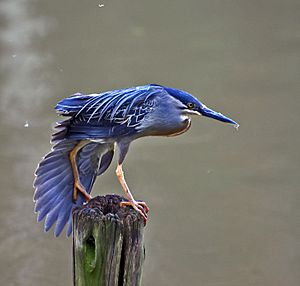Striated Heron facts for kids
The striated heron (Butorides striata) is a small, clever bird often found near water. It's also known by other names like the mangrove heron or green-backed heron. These birds are part of the heron family and are known for their amazing hunting skills. They live in many parts of the world, especially in warmer areas.
Contents
What Does It Look Like?
Striated herons are not very big, usually about 40 to 48 centimeters (16 to 19 inches) tall. They have a dark, greenish-black cap on their head and a short, thick neck. Their back and wings are a dark grey-green, which helps them blend in with plants near the water.
Their underside is a lighter grey, and they have a white stripe down their throat. Young herons look a bit different. They have more brown feathers and streaks on their chest, which helps them hide even better.
Where Do They Live?
Striated herons are found in many places around the world. You can see them in parts of Africa, Asia, Australia, and even South America. They love to live near water, especially in places with lots of trees and plants.
- They often live in mangrove forests, which are special trees that grow in salty water.
- They also like swamps, rivers, lakes, and even ponds in parks.
- These birds need places where they can find food easily and hide from predators.
What Do They Eat?
Striated herons are carnivores, which means they eat meat. Their main diet is small fish. They are very good at catching them!
- Besides fish, they also eat insects like dragonflies and beetles.
- Sometimes, they might catch small frogs, tadpoles, or even tiny crabs.
- They are patient hunters and wait for the perfect moment to strike.
How Do They Hunt?
One of the most interesting things about the striated heron is how it hunts. They are known for being very clever and using tools!
- They often stand very still at the edge of the water, waiting for fish to swim by.
- Sometimes, they drop a small feather, a leaf, or even a piece of bread onto the water. This acts like bait, attracting fish closer to them.
- When a fish comes to investigate the "bait," the heron quickly snatches it with its sharp beak. This smart trick shows how intelligent these birds are.
Life and Family
Striated herons usually live alone or in small groups. When it's time to have babies, they build nests in trees or bushes near water.
- Both the male and female heron help build the nest, which is often a messy platform of sticks.
- The female usually lays two to five eggs.
- Both parents take turns sitting on the eggs to keep them warm until they hatch.
- Once the chicks hatch, both parents work together to feed and protect them until they are old enough to fly and find food on their own.
Images for kids
-
On the Daintree River, North Queensland
See also
 In Spanish: Garcita azulada para niños
In Spanish: Garcita azulada para niños









